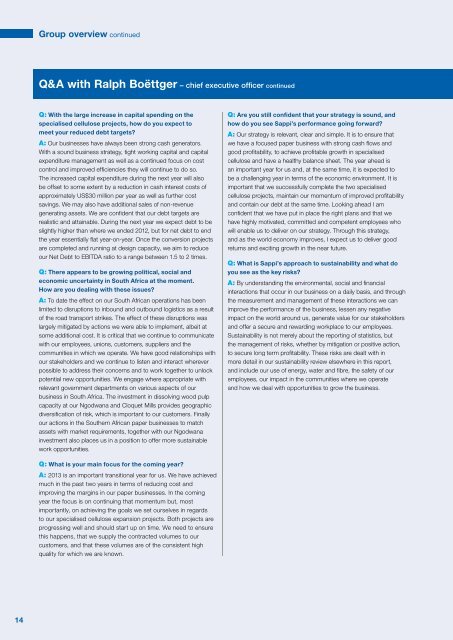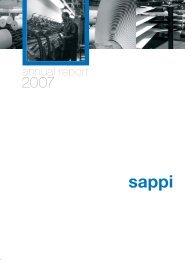2012 Integrated report - Sappi
2012 Integrated report - Sappi
2012 Integrated report - Sappi
Create successful ePaper yourself
Turn your PDF publications into a flip-book with our unique Google optimized e-Paper software.
Group overview continued<br />
Q&A with Ralph Boëttger – chief executive officer continued<br />
Q: With the large increase in capital spending on the<br />
specialised cellulose projects, how do you expect to<br />
meet your reduced debt targets?<br />
A: Our businesses have always been strong cash generators.<br />
With a sound business strategy, tight working capital and capital<br />
expenditure management as well as a continued focus on cost<br />
control and improved efficiencies they will continue to do so.<br />
The increased capital expenditure during the next year will also<br />
be offset to some extent by a reduction in cash interest costs of<br />
approximately US$30 million per year as well as further cost<br />
savings. We may also have additional sales of non-revenue<br />
generating assets. We are confident that our debt targets are<br />
realistic and attainable. During the next year we expect debt to be<br />
slightly higher than where we ended <strong>2012</strong>, but for net debt to end<br />
the year essentially flat year-on-year. Once the conversion projects<br />
are completed and running at design capacity, we aim to reduce<br />
our Net Debt to EBITDA ratio to a range between 1.5 to 2 times.<br />
Q: There appears to be growing political, social and<br />
economic uncertainty in South Africa at the moment.<br />
How are you dealing with these issues?<br />
A: To date the effect on our South African operations has been<br />
limited to disruptions to inbound and outbound logistics as a result<br />
of the road transport strikes. The effect of these disruptions was<br />
largely mitigated by actions we were able to implement, albeit at<br />
some additional cost. It is critical that we continue to communicate<br />
with our employees, unions, customers, suppliers and the<br />
communities in which we operate. We have good relationships with<br />
our stakeholders and we continue to listen and interact wherever<br />
possible to address their concerns and to work together to unlock<br />
potential new opportunities. We engage where appropriate with<br />
relevant government departments on various aspects of our<br />
business in South Africa. The investment in dissolving wood pulp<br />
capacity at our Ngodwana and Cloquet Mills provides geographic<br />
diversification of risk, which is important to our customers. Finally<br />
our actions in the Southern African paper businesses to match<br />
assets with market requirements, together with our Ngodwana<br />
investment also places us in a position to offer more sustainable<br />
work opportunities.<br />
Q: Are you still confident that your strategy is sound, and<br />
how do you see <strong>Sappi</strong>’s performance going forward?<br />
A: Our strategy is relevant, clear and simple. It is to ensure that<br />
we have a focused paper business with strong cash flows and<br />
good profitability, to achieve profitable growth in specialised<br />
cellulose and have a healthy balance sheet. The year ahead is<br />
an important year for us and, at the same time, it is expected to<br />
be a challenging year in terms of the economic environment. It is<br />
important that we successfully complete the two specialised<br />
cellulose projects, maintain our momentum of improved profitability<br />
and contain our debt at the same time. Looking ahead I am<br />
confident that we have put in place the right plans and that we<br />
have highly motivated, committed and competent employees who<br />
will enable us to deliver on our strategy. Through this strategy,<br />
and as the world economy improves, I expect us to deliver good<br />
returns and exciting growth in the near future.<br />
Q: What is <strong>Sappi</strong>’s approach to sustainability and what do<br />
you see as the key risks?<br />
A: By understanding the environmental, social and financial<br />
interactions that occur in our business on a daily basis, and through<br />
the measurement and management of these interactions we can<br />
improve the performance of the business, lessen any negative<br />
impact on the world around us, generate value for our stakeholders<br />
and offer a secure and rewarding workplace to our employees.<br />
Sustainability is not merely about the <strong>report</strong>ing of statistics, but<br />
the management of risks, whether by mitigation or positive action,<br />
to secure long term profitability. These risks are dealt with in<br />
more detail in our sustainability review elsewhere in this <strong>report</strong>,<br />
and include our use of energy, water and fibre, the safety of our<br />
employees, our impact in the communities where we operate<br />
and how we deal with opportunities to grow the business.<br />
Q: What is your main focus for the coming year?<br />
A: 2013 is an important transitional year for us. We have achieved<br />
much in the past two years in terms of reducing cost and<br />
improving the margins in our paper businesses. In the coming<br />
year the focus is on continuing that momentum but, most<br />
importantly, on achieving the goals we set ourselves in regards<br />
to our specialised cellulose expansion projects. Both projects are<br />
progressing well and should start up on time. We need to ensure<br />
this happens, that we supply the contracted volumes to our<br />
customers, and that these volumes are of the consistent high<br />
quality for which we are known.<br />
14
















